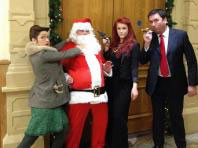
Who Killed Father Christmas?
Posted on 21st Oct 2014
It's much too early for Christmas decorations, in spite of the shops starting to stock up, but you really should be booking your Christmas party now. Our Who Killed Father Christmas Murder Mystery will be available for Christmas Parties from mid November, so we thought we'd take a look at the origins of the Santa legend.
In a list of known aliases, Santa Claus would have more than most. Santa Claus, Father Christmas, St. Nicholas or Kris Kringle all create an image of a large elderly man with a red suit and a long white beard. With Christmas fast approaching, it’s time to take a look at the man behind the suit and understand where he come from….apart from the North Pole of course.
The earliest origins of Father Christmas as a Christian symbol can be traced back to the 4th Century. In what is now Turkey, there lived Bishop Nicholas of Smyrna, a generous man who loved children. To spread joy, he would travel the country throwing presents through the windows of poor children and helping those less fortunate than himself. Thanks to stories of incredible generosity, the Roman Catholic church would eventually honour Nicholas and make him a Saint. He became St. Nicholas, the patron saint of children (and seafarers). St. Nicholas died on 6th December which became his ‘feast day’ when his reputation continued to be celebrated, especially in Holland. Around the same time Pope Julius I decided to establish a date to celebrate the birth of Jesus. As the original date was unknown, he used the date of the Pagan midwinter festival that took place on 25th December. Eventually, the two dates became one and the connection with Christ Mass (or Christmas) and St. Nicholas was cemented. A tradition soon developed that St. Nicholas would visit children on Christmas Eve to deliver nuts and fruit to them, and reciprocally other items would be left around the house to welcome him.
Over the years the symbol of Father Christmas became a combination of many different legends, stories and traditions. In England he became Father Christmas and in Germany he was originally known as die Weinachtsmann. Modern day Santa Claus owes its etymology to the traditional Dutch figure of Sinter Klaas, based on Saint Nicholas. When Dutch settlers arrived in New York in the 18th Century, or New Amsterdam as it was originally known, they brought with them their tradition of Sinter Klaas. Dutch immigrants continued to gather to honour the anniversary of St. Nicholas’s death. This celebration was soon picked up by a New York newspaper and the stories spread. Over the years, their traditions were gradually Americanised, taking the best of both versions and moulding them together. The modern look of Father Christmas, as we would recognise him today, was first depicted in a poem written in 1823. Thomas Nast’s illustrations for Clement Clark Moore’s poem ‘An Account of a Visit From St. Nicholas’ were the first to show Santa as a portly, grand-fatherly gentleman together with a long, white, fluffy beard clutching an arm full of presents. The poem and particularly the illustrations became incredibly popular in North America and Canada and soon became the benchmark for how Father Christmas would look in the western world. His name eventually morphed from Sinter Klaas into Santa Claus. You might think a poem with such cultural significance would be better known around the world and you’d be right. It’s still a famous poem but you probably know it by a different name; it’s more commonly known as ’The Night Before Christmas’.
Over the years, Nast’s illustrations gained a foothold in American culture. His designs gained more of the traditions we hold dear today. Due to their popularity, Harper’s Weekly magazine commissioned many more Christmas drawing’s from him between 1860 and 1880 for their festive issues. With every new cover, Nast elaborated on Santa’s backstory. It was Nast who created the workshop in the North Pole, gave him a wife; Mrs. Claus, made Santa ‘human-sized’ (he was originally referred to as an elf in the poem) and borrowed the Dutch tradition for a naughty and nice list of children. Due to printing restrictions of the time, the drawings were all black and white. His suit didn’t become red until Coca-Cola used it in their advertisements in 1931.
In many counties, including the UK, Santa Claus still delivers his presents to children on the nice list on Christmas Eve, but that isn’t the same around the world. In some European countries, children receive their presents a little earlier on St. Nicholas’s Day, 6th December. In the western world, Father Christmas is now recognised by the images created all those years ago. Around the world, similar legends told different stories but share similar traits. Christkind (meaning Christ Child, an angel-like figure who accompanies St. Nicholas) or Kris Kringle deliver presents to well-behaved Swiss and German children, Pere Noel fills the shoes of French children and in Russia, Baboushchka, an elderly woman, leaves gifts and the end of the bed for children on January 5th.
A multitude of different legends and a stocking full of stories all show the world that an overweight man in a red suit isn’t everyone’s idea of Christmas, but thankfully goodwill to all man can survive at least one day a year.
Organise Events
Twin Oaks Lodge, Mount Pleasant Lane, Lymington, Hampshire, SO41 8LS | Registered Company Number: 9066720
©2025 organise.co.uk all rights reserved | Site Map | Contact Us | Terms & Conditions | Privacy Policy
